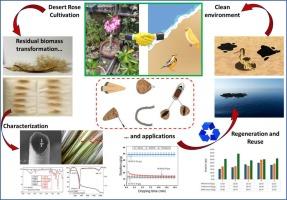探索沙漠玫瑰纤维(Adenium obesum)修复石油污染场地的潜力
IF 6.3
2区 工程技术
Q1 ENGINEERING, CHEMICAL
引用次数: 0
摘要
本研究提出使用沙漠玫瑰荚果纤维(DRF)作为在溢油情况下去除油污和清洁受污染鸟类羽毛的替代品。通过动力学测试评估了生物质的吸附能力,并使用分形线性驱动力(FL-LDF)模型对其进行了调整。此外,还进行了捕获稳定性测试,以确定材料的留油能力。此外,还对 DRF 进行了鸟类羽毛清洁测试,并使用光学显微镜(OM)、扫描电镜、傅立叶变换红外光谱(FTIR)和热重分析(TGA)对纤维进行了表征。DRF 对柴油、20 W50 矿物油和石油的吸附效率分别约为 13.01 ± 1.87 g/g、14.59 ± 0.58 g/g 和 49.12 ± 2.43 g/g。研究发现,这些结果是通过将粘度与材料表面识别出的官能团相结合而得出的,官能团对吸附能力有很大的影响。吸附动力学表明,在对柴油和 20 W50 进行测试的第一分钟,吸附速度很快。这种材料仍然很稳定,能保留 65%、83% 和 78%的柴油、20 W50 和石油,并能从羽毛中去除 82%、71% 和 81%的柴油、20 W50 和石油。生物质呈现出中空的圆柱形结构,其表面的某些区域存在凹槽和粗糙度,壁很薄,这表明它是一种高效且有竞争力的吸油剂。本文章由计算机程序翻译,如有差异,请以英文原文为准。

Exploring the potential of Desert Rose fibers (Adenium obesum) for the remediation of oil-contaminated sites
This work proposes the use of Fibers from the pod of Desert Rose, Adenium obesum (DRF), as an alternative for oil removal in spill scenarios and cleaning of contaminated bird feathers. The sorption capacity of biomass was evaluated through kinetics tests, which were adjusted using the Fractal Linear Driving Force (FL-LDF) model. Additionally, capture stability tests were performed to determine the oil retention capacity of the material. Furthermore, the DRF were tested in the cleaning of bird feathers, and the fibers were characterized using Optical Microscopy (OM), SEM, FTIR and TGA. The DRF demonstrated sorption efficiency, with approximately 13.01 ± 1.87 g/g, 14.59 ± 0.58 g/g and 49.12 ± 2.43 g/g, for diesel oils, 20 W50 mineral oil and petroleum, respectively. It was found that these results were achieved by combining the viscosity with the functional groups identified on the material surface, which strongly contributed to the sorption capacity. The sorption kinetics indicated a fast rate in the first minute of testing for diesel oils and 20 W50. The material was still stable, managing to retain 65 %, 83 % and 78 % and removing from the feathers a total of 82 %, 71 % and 81 % of diesel oils, 20 W50 and petroleum. The biomass presented a hollow cylindrical structure, with the presence of grooves and roughness in some regions of its surface with a thin wall, demonstrating to be an efficient and competitive oil sorbent.
求助全文
通过发布文献求助,成功后即可免费获取论文全文。
去求助
来源期刊

Journal of water process engineering
Biochemistry, Genetics and Molecular Biology-Biotechnology
CiteScore
10.70
自引率
8.60%
发文量
846
审稿时长
24 days
期刊介绍:
The Journal of Water Process Engineering aims to publish refereed, high-quality research papers with significant novelty and impact in all areas of the engineering of water and wastewater processing . Papers on advanced and novel treatment processes and technologies are particularly welcome. The Journal considers papers in areas such as nanotechnology and biotechnology applications in water, novel oxidation and separation processes, membrane processes (except those for desalination) , catalytic processes for the removal of water contaminants, sustainable processes, water reuse and recycling, water use and wastewater minimization, integrated/hybrid technology, process modeling of water treatment and novel treatment processes. Submissions on the subject of adsorbents, including standard measurements of adsorption kinetics and equilibrium will only be considered if there is a genuine case for novelty and contribution, for example highly novel, sustainable adsorbents and their use: papers on activated carbon-type materials derived from natural matter, or surfactant-modified clays and related minerals, would not fulfil this criterion. The Journal particularly welcomes contributions involving environmentally, economically and socially sustainable technology for water treatment, including those which are energy-efficient, with minimal or no chemical consumption, and capable of water recycling and reuse that minimizes the direct disposal of wastewater to the aquatic environment. Papers that describe novel ideas for solving issues related to water quality and availability are also welcome, as are those that show the transfer of techniques from other disciplines. The Journal will consider papers dealing with processes for various water matrices including drinking water (except desalination), domestic, urban and industrial wastewaters, in addition to their residues. It is expected that the journal will be of particular relevance to chemical and process engineers working in the field. The Journal welcomes Full Text papers, Short Communications, State-of-the-Art Reviews and Letters to Editors and Case Studies
 求助内容:
求助内容: 应助结果提醒方式:
应助结果提醒方式:


